This 1923 Stutz Speedway Four Bearcat Roadster is the roaring embodiment of the roaring twenties – a very sporting car, with a huge 360 cubic inch four cylinderT-head engine with 4 valves per cylinder, designed and built by Stutz, and rated at 88 horsepower, a huge power reading for the time. Chassis features include 3 speed transaxle, 130 inch wheelbase, and Houck wire wheels with 33X5 tires.
 .
.
This car benefits from an engine rebuild by Stutz Expert Paul Freehill sometime in the late 1990’s or early 2000’s. It’s been driven about 5,000 miles in the last 10 years, including frequent appearances at the Holiday motor tour, the Mozart Tour and the Modoc tour. Consistent maintenance and mechanical improvements were carried out by the well known and well regarded Mosier, inc. in El Segundo. More recently, it has had a new wiring harness installed, gauges calibrated, and a new U-joint . The owners of this car have been totally committed to keeping it in excellent operating condition!
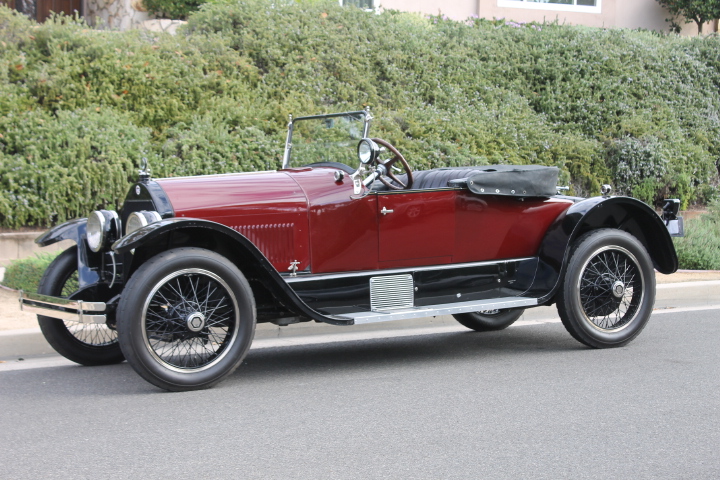 .
.
It’s huge fun to drive – especially with the exhaust cut-out open!
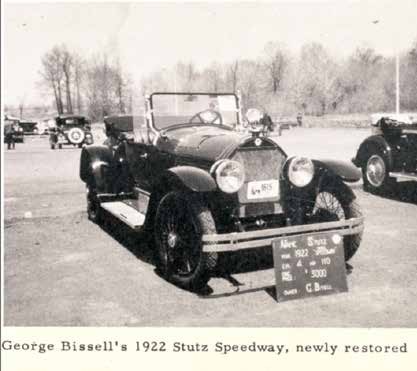 The car was cosmetically restored and painted maroon in the early ‘60s. The restoration was nicely done, though not body-off. It was then shown on June 20, 1964 at the Newport (RI) Festival. (The famous Newport Jazz Festival was held the following weekend and the Folk Festival two weeks after that.) The automobile event associated with the Festival was the VMCCA Eastern Section National Meet. In the July-August 1964 issue of the VMCCA journal, The Bulb Horn it was reported that the car won first place in Class 17 and garnered the most overall points at the meet. It was described as “newly restored.” The owner is listed as A.G. (Arthur Gilbert) Bissell, Jr. of Suffield, CT. In the magazine article, the car is incorrectly listed as 1922, apparently because the owner thought that was the correct year. Later in 1964 the car was shown at a VMCCA Connecticut Valley Regional meet. Following that it took a prize as best-of show 1920s car at Canton, CT, and won a top prize at a Sheffield, CT meet. The restoration was obviously well done. It had CT Horseless Carriage plate 1615.
The car was cosmetically restored and painted maroon in the early ‘60s. The restoration was nicely done, though not body-off. It was then shown on June 20, 1964 at the Newport (RI) Festival. (The famous Newport Jazz Festival was held the following weekend and the Folk Festival two weeks after that.) The automobile event associated with the Festival was the VMCCA Eastern Section National Meet. In the July-August 1964 issue of the VMCCA journal, The Bulb Horn it was reported that the car won first place in Class 17 and garnered the most overall points at the meet. It was described as “newly restored.” The owner is listed as A.G. (Arthur Gilbert) Bissell, Jr. of Suffield, CT. In the magazine article, the car is incorrectly listed as 1922, apparently because the owner thought that was the correct year. Later in 1964 the car was shown at a VMCCA Connecticut Valley Regional meet. Following that it took a prize as best-of show 1920s car at Canton, CT, and won a top prize at a Sheffield, CT meet. The restoration was obviously well done. It had CT Horseless Carriage plate 1615.
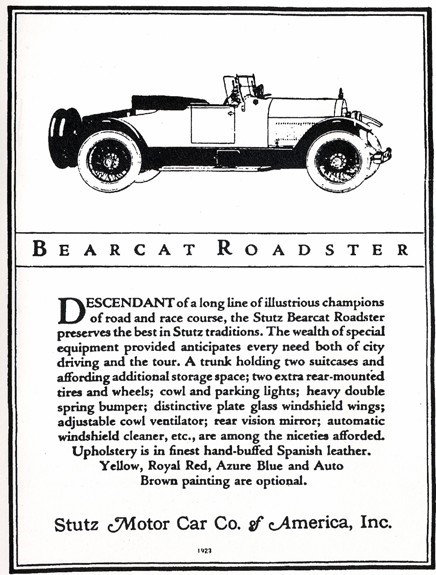 .
.
by January 1923, the company named the entire 4-cylinder line of cars “Speedway 4” and resurrected the Bearcat name in their advertising. What was called the “Speedway Roadster” became a “Speedway 4 Bearcat Roadster,” or just a “Bearcat Roadster” as is illustrated in this ad. There were no changes made to the car…the 1922 Speedway 4 Roadster was identical to the 1923 Bearcat Roadster. In fact, the serial number tag on the dash still read only “Speedway 4.” The standard roadster continued to be offered and was called a Speedway 4. Only 1,229 cars of all body styles were sold by Stutz in 1922, and an estimated 460 of these were left-over 1921 models. 1923 4-cylinder production was a mere 427 cars, and in 1924, the last year for the big T-head 4-cylinder 16-valve Stutz, only 184 were sold. It was replaced by the Speedway 6, which was introduced early in 1923, and then by the Vertical-eight “Safety Stutz” in 1926.
The Bearcat livery was the way Chassis No 13252 began life. It was neither an early nor a late 1923 model; the serial number indicating that it was 60% of the way through 1923’s production. Based on the excellent condition of the wood and complete lack of rust, it was very well taken care of. In fact, it was not driven much at all, having only 30,000 miles on the odometer in 2009, which might be the original mileage, but can’t be guaranteed. We think it was always stored inside.
n the late 1990s the two rear spares, suitcase and wind wings were removed and replaced with a single spare on the rear deck. Well-respected Stutz expert Paul Freehill of Ft. Wayne, IN rebuilt the engine using high compression aluminum pistons; the date of this is, however, unknown.
 .
.
Here’s the rear view of this incredibly sporting car!
 .
.
The nickel plating on this car was redone recently, and it’s in excellent condition, including the bumpers, wheel snap rings, headlight rims and more.
.


The headlights, spotlights, and tail lamp all work properly, – the new wiring harness was done nicely and authentically, and works great!

.
The Stutz Logo fuel gauge looks great and works, too. This is a pressurized gas tank fuel delivery system – there’s a pump on the dashboard, and a gauge that shows the tank pressure to deliver fuel to the carburetor.
 .
.
Beautiful tail lamp.
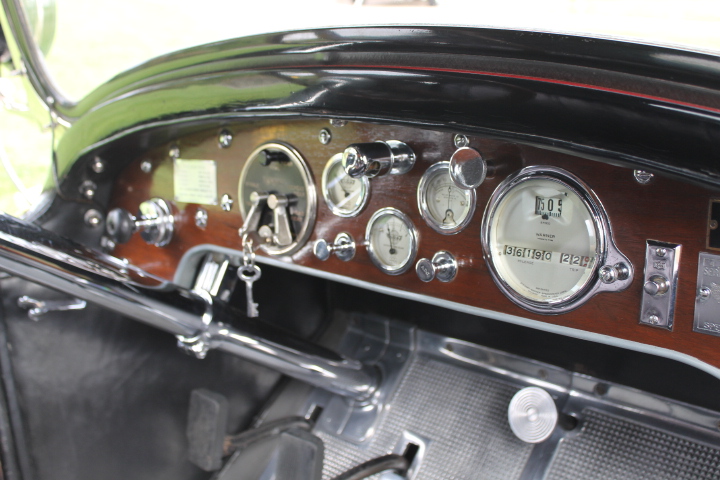 .
.
the dashboard is spectacular, and all of the instruments work properly and register appropriately.
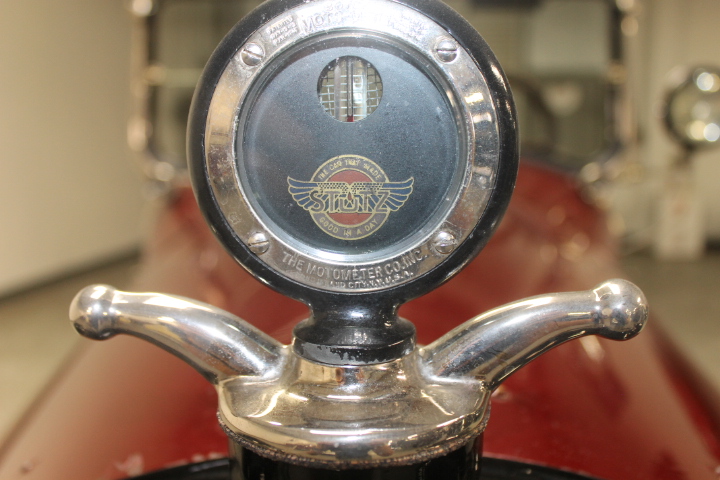 .
.
And the Stutz logo Moto-Meter temperature gauge.
 .
.
Nice leather interior, holding up really well from it’s likely 1960’s installation.
 .
.
I love the beveled glass rear window.
 .
.
And the beautifully restored wood steering wheel.
 .
.
Here’s the Stutz Serial number plate and the VMCCA tag from 1964 from the event shown in the black & white photo.
 .
.
Stutz Logo Delco ignition / Lamp switches.
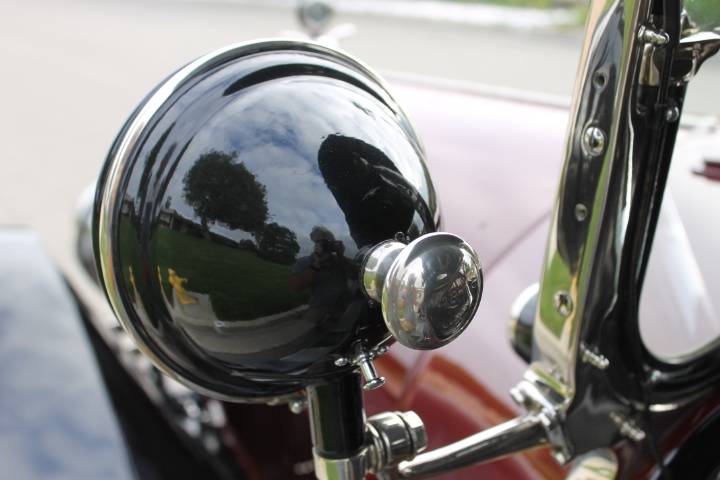 .
.
Beautifully restored – and working – spotlight
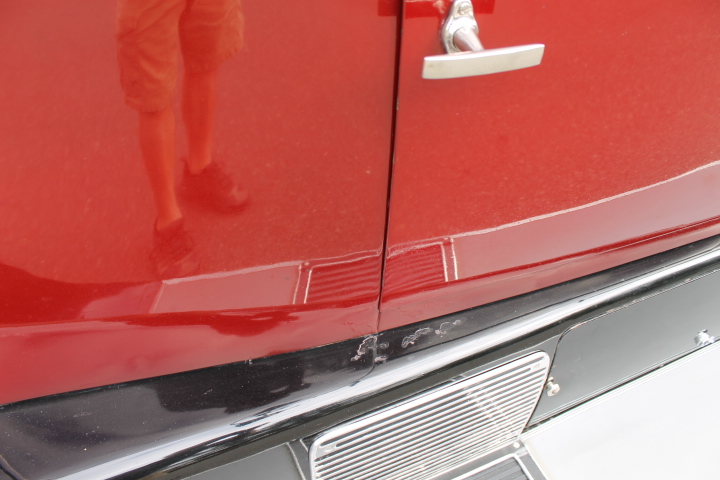 .
.
The paint job is old – it takes a shine, although there are a number of paint flaws, like these chips, that would keep it from being a show trophy winner today. I bet this car is a lot more fun to drive than most show ponies !
 .
.
That’s quite an engine – 360 cubic inches, T-head, meaning twin camshafts, one on each side of the engine, 4 valves per cylinder, and 88 horsepower! It runs really great!
 .
.
Here’s the exhaust and water pump side. Porcelain is still pretty good, and the water pump is nicely polished. Also note the correct appearing leather fan belt.
 .
.
Stutz Logo Delco dual distributor.
 .
.
Stutz side plates on the engine
 .
.
Here it is with the top up. There are sidecurtains too inside the boot area, along with an original style generator.
 .
.
Beautiful!
 .
.
Spectacular!
 .
. .
. The car was cosmetically restored and painted maroon in the early ‘60s. The restoration was nicely done, though not body-off. It was then shown on June 20, 1964 at the Newport (RI) Festival. (The famous Newport Jazz Festival was held the following weekend and the Folk Festival two weeks after that.) The automobile event associated with the Festival was the VMCCA Eastern Section National Meet. In the July-August 1964 issue of the VMCCA journal, The Bulb Horn it was reported that the car won first place in Class 17 and garnered the most overall points at the meet. It was described as “newly restored.” The owner is listed as A.G. (Arthur Gilbert) Bissell, Jr. of Suffield, CT. In the magazine article, the car is incorrectly listed as 1922, apparently because the owner thought that was the correct year. Later in 1964 the car was shown at a VMCCA Connecticut Valley Regional meet. Following that it took a prize as best-of show 1920s car at Canton, CT, and won a top prize at a Sheffield, CT meet. The restoration was obviously well done. It had CT Horseless Carriage plate 1615.
The car was cosmetically restored and painted maroon in the early ‘60s. The restoration was nicely done, though not body-off. It was then shown on June 20, 1964 at the Newport (RI) Festival. (The famous Newport Jazz Festival was held the following weekend and the Folk Festival two weeks after that.) The automobile event associated with the Festival was the VMCCA Eastern Section National Meet. In the July-August 1964 issue of the VMCCA journal, The Bulb Horn it was reported that the car won first place in Class 17 and garnered the most overall points at the meet. It was described as “newly restored.” The owner is listed as A.G. (Arthur Gilbert) Bissell, Jr. of Suffield, CT. In the magazine article, the car is incorrectly listed as 1922, apparently because the owner thought that was the correct year. Later in 1964 the car was shown at a VMCCA Connecticut Valley Regional meet. Following that it took a prize as best-of show 1920s car at Canton, CT, and won a top prize at a Sheffield, CT meet. The restoration was obviously well done. It had CT Horseless Carriage plate 1615. .
. .
. .
.


 .
. .
. .
. .
. .
. .
. .
. .
. .
. .
. .
. .
. .
. .
. .
. .
. .
.